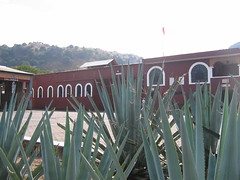
New trend finds partygoers switching from body shots to sipping cocktails
by DAVID AGREN
Jose Hermosillo, owner of Casa Noble Tequila, pours shots of añejo tequila into snifter glasses sitting on a bar at his company’s 24-hecatre compound in Tequila, Mexico. But no one dares throw back the triple-distilled spirit quickly – a 750 millilitre bottle sells for $80. Smooth and complex, with an interesting nose and an almost buttery texture, it comes in a hand-painted porcelain bottle adorned with 18-karat gold detailing.
Once a beverage associated with Mexican holidays, booze-fuelled debauchery and nasty hangovers, Mexico’s best-known export has increasingly moved upscale, finding a spot on the top shelves of liquor cabinets and commanding steep prices from discerning connoisseurs, who often sip ultra premium tequilas like they would a fine scotch whisky or bourbon.
Casa Noble now exports all over the world, finding enthusiasts in countries as diverse as Australia, Japan, South Africa, the United Kingdom and Russia, where Hermosillo says young people, flush with cash and an appetite for something other than vodka, are fuelling a premium tequila boom. The demand, however, is especially strong in Canada and the United States.
While industry giants like Jose Cuervo and Sauza have long distilled premium products, their best reservas and reposados received little fanfare until recently, joining a slew of export-only tequilas from craft distillers. The enormous popularity of premium tequila has even drawn celebrities into the business. Van Halen front man Sammy Hagar launched the Cabo Wabo brand, and actor Dan Aykroyd scooped up the Canadian rights to Patron Tequila.
Knock-offs have arrived on store shelves, too. A Southern California company now distils a tequila-like beverage from U.S.-grown agaves, initially selling it under the name "Temequila" – a word play on the town where the beverage is bottled.
"Tequila is taking advantage of the trend in the spirits industry that people want to drink better liquor," says David Ozgo, an economist with the Distilled Spirits Council of the United States.
Drinking better often means paying more, but consumers seem more than willing to spend big on tequila. Growth in the top end of the tequila market is expected to outpace sales for regular tequilas for the rest of the decade – consumption jumped by a staggering 29 per cent in 2004.
Several factors, both intentional and serendipitous, have propelled premium tequila’s popularity. According to Bertha Becerra, spokeswoman for the Guadalajara-based Tequila Regulatory Council (CRT), manufacturers began distilling better beverages, investing in new technologies and improving production techniques. Firms also marketed their products more effectively, leveraging tequila’s appellation of origin distinction, which imbues it with a certain cachet – similar to luxury drinks like cognac and champagne (by law, tequila must be made from blue agave plants grown in Jalisco, and designated municipalities in Guanajuato, Michoacan, Nayarit and Tamaulipas states).
With the prices of mid-range tequilas falling due to a surplus of agave plants – tequila’s principal ingredient – Mexico’s famed firewater is favourably competing against longtime cocktail standbys like rum and vodka.
To conquer new markets, the CRT recently authorized the production of flavoured tequilas, and created a new category for extra-aged tequila. Before the rule changes, añejo tequila only needed to rest for one year. Relatively young tequilas were lumped in with beverages spending nearly five years in a barrel.
Small but important details differentiate premium tequilas from their mass-market counterparts. Many premium distillers, like Casa Noble, grow their own agaves without the use of chemicals, steam roast the agave hearts in stone ovens and naturally ferment the agave juice.
During the distillation, Casa Noble discards the "heads and tails" – the first and last parts of the batch. The practice, along with triple distilling, supposedly reduces the levels of hangover-inducing methanol and other unpleasant elements. The final product rests in barrels made from new wood for just under five years (many distillers use old whisky barrels for aging tequila).
While some whiskies spend more than 20 years in a barrel, Hermosillo says five years is ample time.
"After a certain period of time, you lose a lot of the properties of the agaves… and the properties of the barrel take over."
Ultimately, Hermosillo says, "If you combine all these complexities, you’ll get a great spirit – not just a great tequila."
And, while premium tequila would make a great margarita, save it for sipping. "It’s not for mixing," he says.
From FFWD (Calgary)


No comments:
Post a Comment